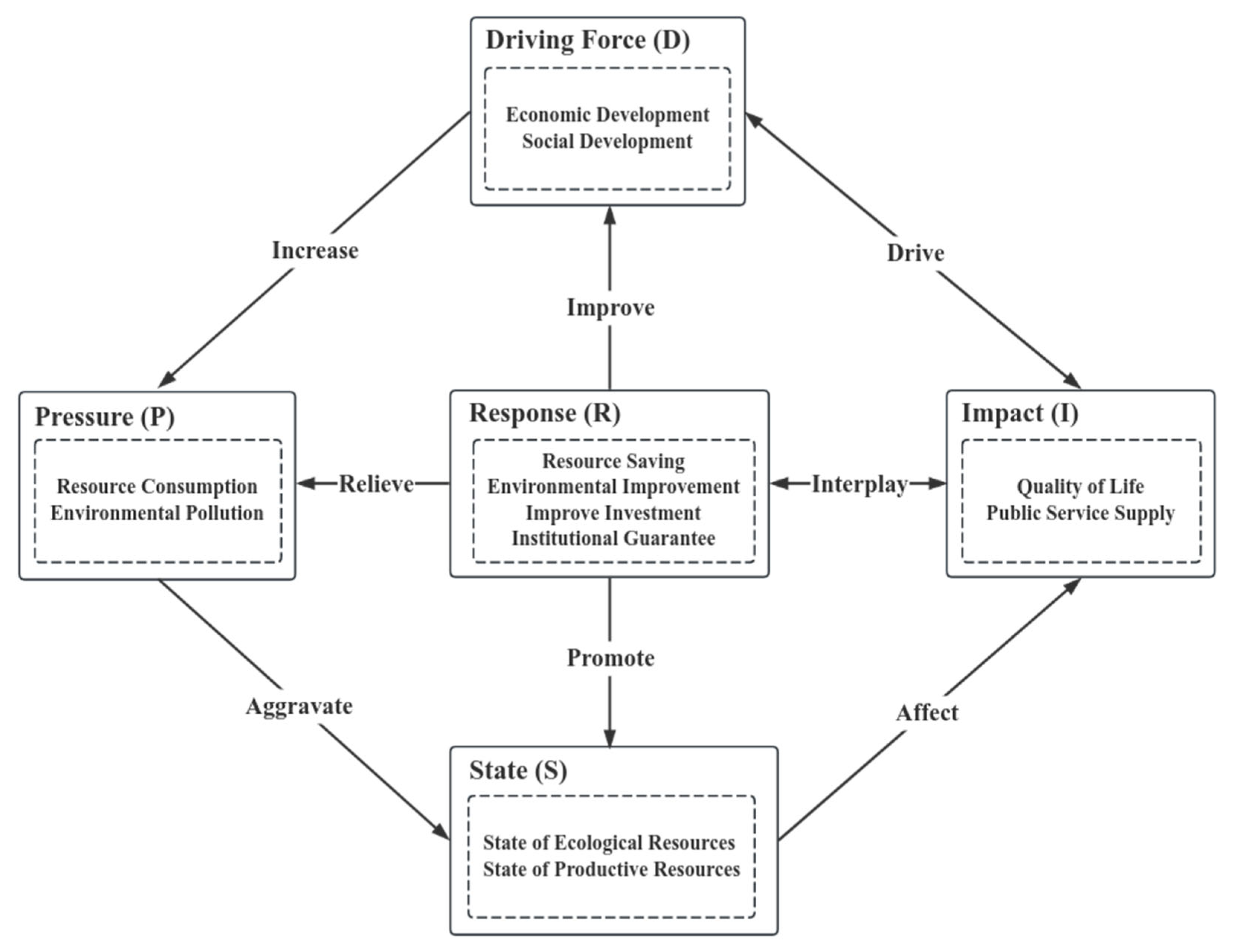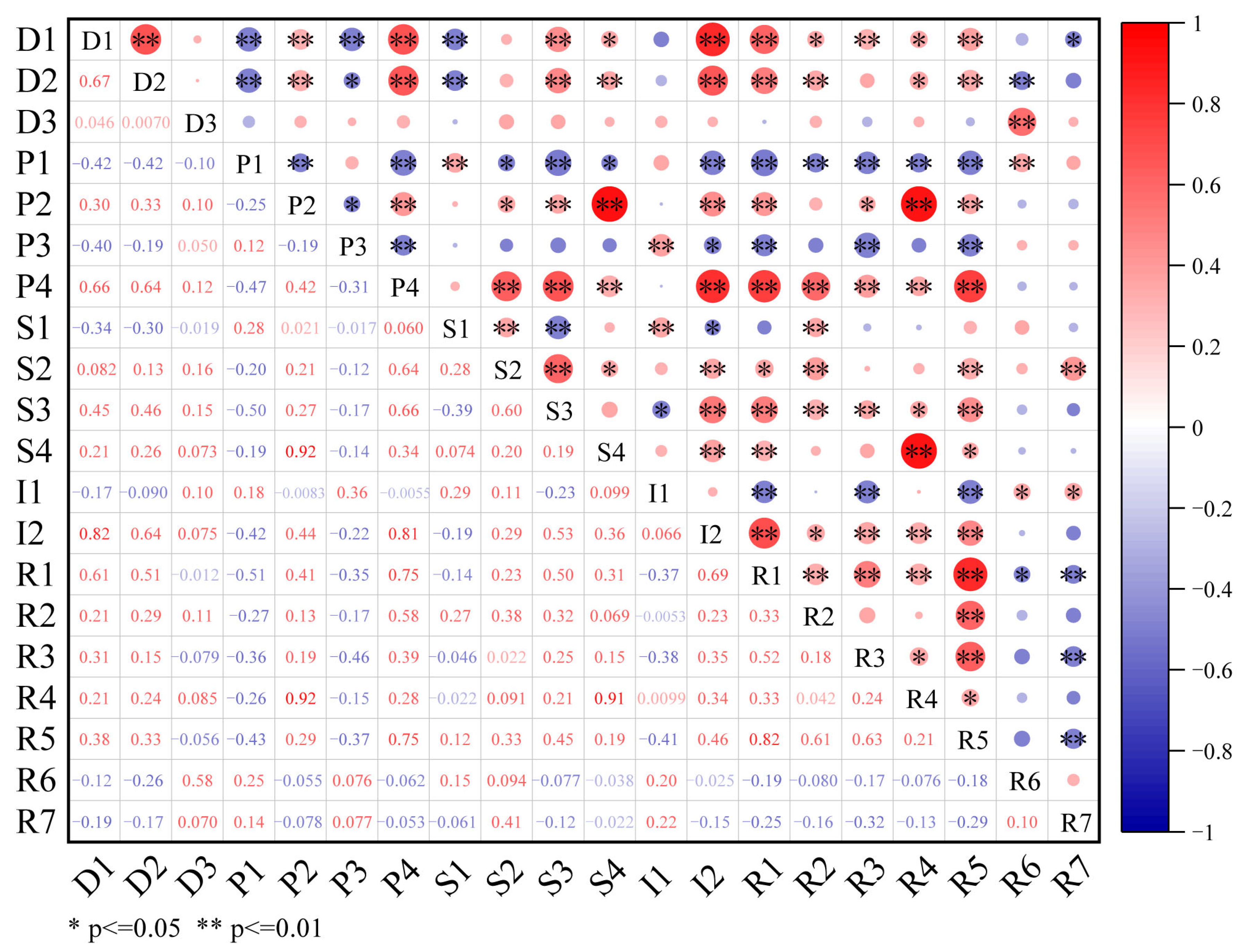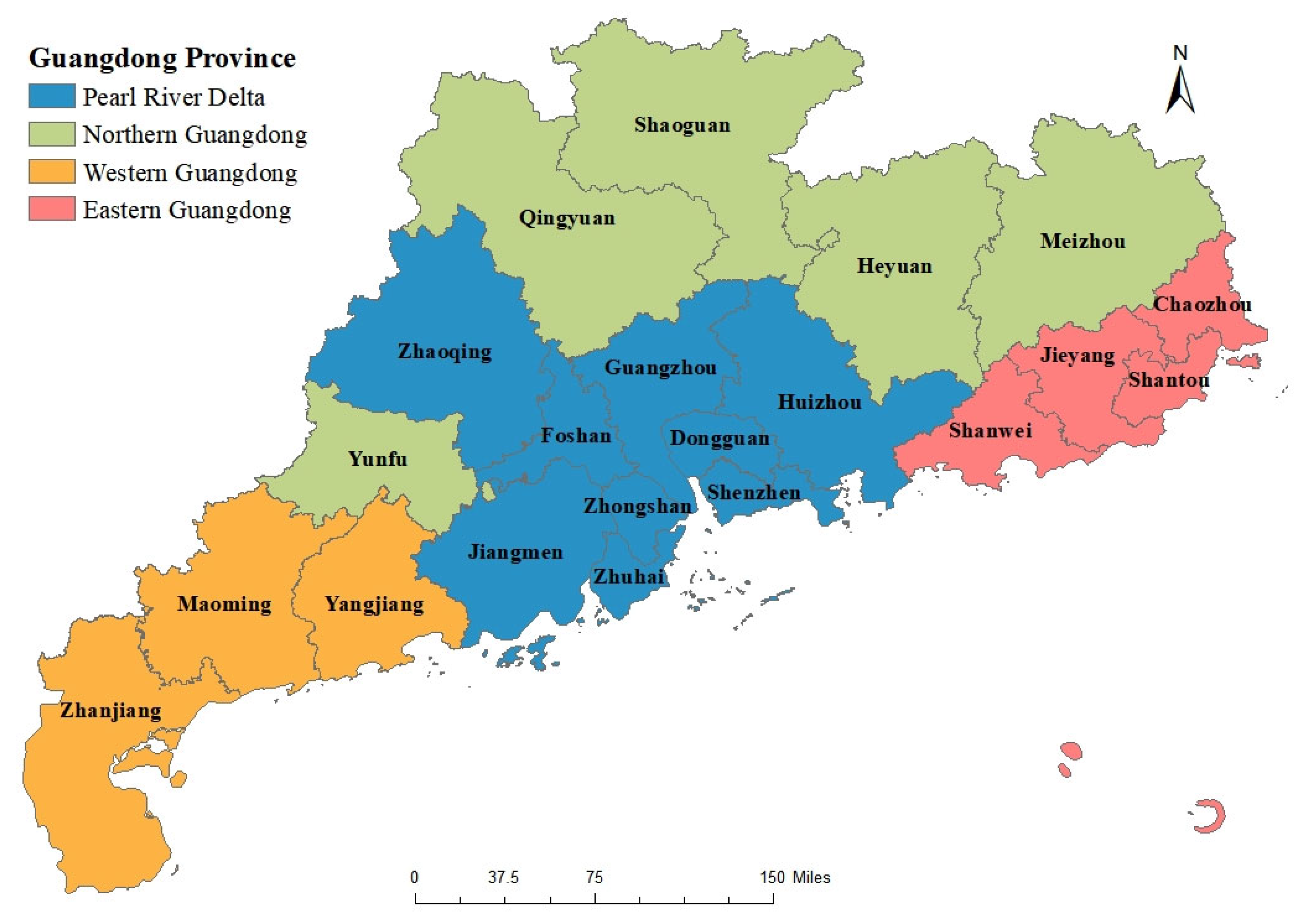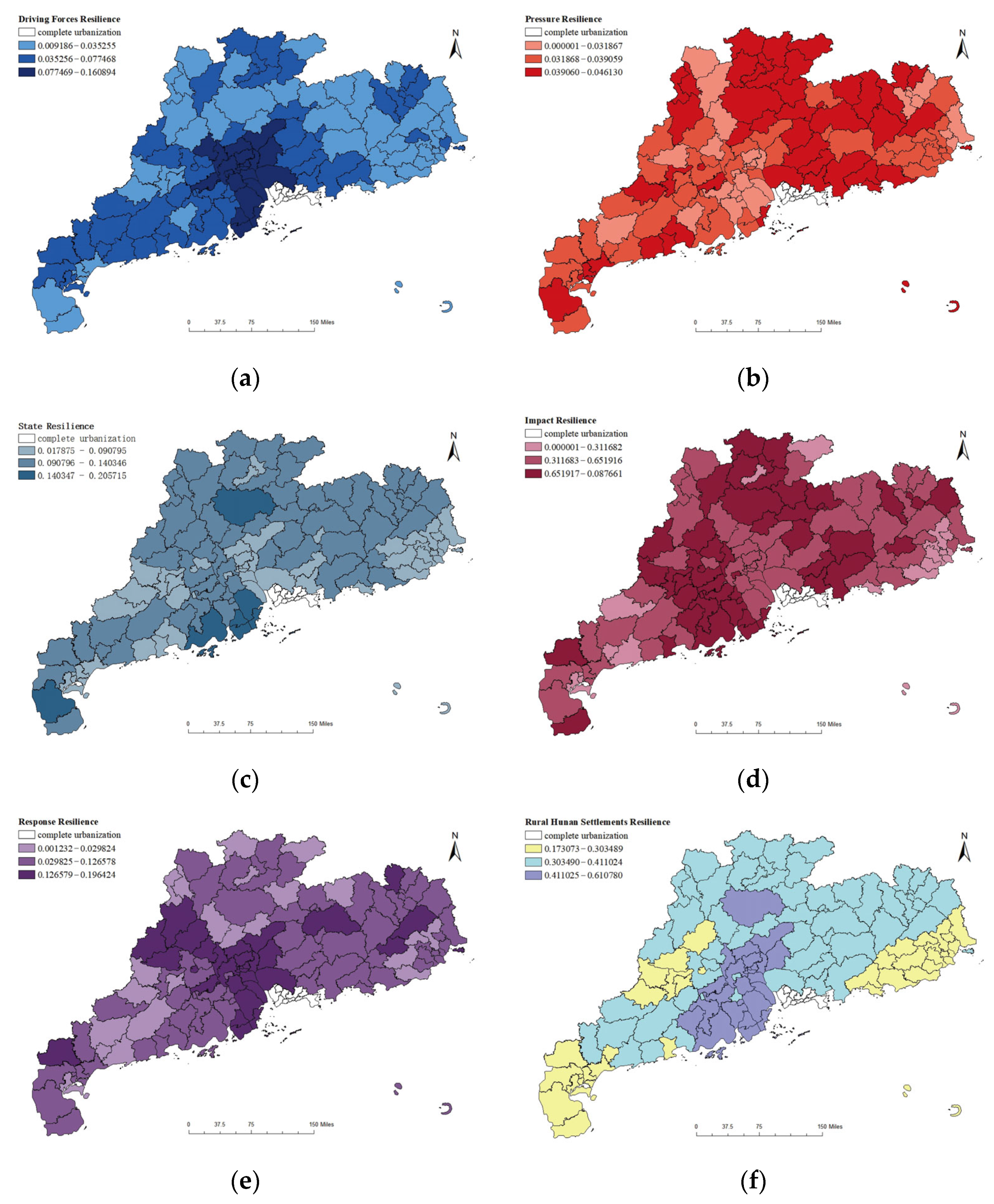Driving Force–Pressure–State–Impact–Response-Based Evaluation of Rural Human Settlements’ Resilience and Their Influencing Factors: Evidence from Guangdong, China
Abstract
1. Introduction
2. Construction of Rural Human Settlements’ Resilience Evaluation System
2.1. Application of the DPSIR Model
2.2. Rural Human Settlements’ Resilience Evaluation System Construction
3. Materials and Methods
3.1. Study Area
3.2. Data Sources
3.3. Research Methodology
3.3.1. Determine the Weights of Indicators Using the Entropy Method
- (1)
- Apply the extreme value method to standardize the indicator data. Use the following formula:
- (2)
- Calculate the weight of the indicator for the evaluation sample.
- (3)
- Calculate the entropy value of the indicator.
- (4)
- Calculate the information entropy redundancy of the indicator.
- (5)
- Calculate the weight of the indicator.
3.3.2. Evaluation of Rural Human Settlements’ Resilience
3.3.3. Geographically Weighted Regression Model
4. Results
4.1. Rural Human Settlements’ Resilience Evaluation Indicators System
4.2. Rural Human Settlements’ Resilience Horizontal Spatial Patterns
4.2.1. Spatial Distribution Characteristics of Driving Force Resilience
4.2.2. Spatial Distribution Characteristics of Pressure Resilience
4.2.3. Spatial Distribution Characteristics of State Resilience
4.2.4. Spatial Distribution Characteristics of Impact Resilience
4.2.5. Spatial Distribution Characteristics of Response Resilience
4.2.6. Spatial Distribution Characteristics of Rural Human Settlements’ Resilience
4.3. The Spatial Differences of Factors Affecting the Rural Human Settlements Resilience
4.3.1. Spatial Distribution Characteristics of the Coefficient of Driving Force Resilience
4.3.2. Spatial Distribution Characteristics of the Coefficient of Pressure Resilience
4.3.3. Spatial Distribution Characteristics of the Coefficient of State Resilience
4.3.4. Spatial Distribution Characteristics of the Coefficient of Impact Resilience
4.3.5. Spatial Distribution Characteristics of the Coefficient of Response Resilience
5. Discussion
6. Conclusions
Author Contributions
Funding
Institutional Review Board Statement
Informed Consent Statement
Data Availability Statement
Conflicts of Interest
References
- Lin, S.; Hou, L. SDGs-oriented evaluation of the sustainability of rural human settlement environment in Zhejiang, China. Heliyon 2023, 9, e13492. [Google Scholar] [CrossRef] [PubMed]
- Hu, Q.; Wang, C. Quality evaluation and division of regional types of rural human settlements in China. Habitat Int. 2020, 105, 102278. [Google Scholar] [CrossRef]
- Liao, L.; Du, M.; Chen, Z. Environmental pollution and socioeconomic health inequality: Evidence from China. Sustain. Cities Soc. 2023, 95, 104579. [Google Scholar] [CrossRef]
- Shi, J.; Yang, X. Sustainable Development Levels and Influence Factors in Rural China Based on Rural Revitalization Strategy. Sustainability 2022, 14, 8908. [Google Scholar] [CrossRef]
- Li, X.; Yu, B.; Cui, J.; Zhu, Y. Building a New Framework for Evaluating the Livability of Living Space on the Basis of the Daily Activities of Rural Residents: A Case Study of Jianghan Plain. Int. J. Environ. Res. Public Health 2022, 19, 10615. [Google Scholar] [CrossRef]
- Zhang, K.H.; Song, S. Rural-urban migration and urbanization in China: Evidence from time-series and cross-section analyses. China Econ. Rev. 2003, 14, 386–400. [Google Scholar] [CrossRef]
- Wang, H.; Zhuo, Y. The Necessary Way for the Development of China’s Rural Areas in the New Era-Rural Revitalization Strategy. Open J. Soc. Sci. 2018, 6, 97–106. [Google Scholar] [CrossRef]
- Liu, Q.; Gong, D.; Gong, Y. Index system of rural human settlement in rural revitalization under the perspective of China. Sci. Rep. 2022, 12, 10586. [Google Scholar] [CrossRef]
- Du, M.; Wu, F.; Ye, D.; Zhao, Y.; Liao, L. Exploring the effects of energy quota trading policy on carbon emission efficiency: Quasi-experimental evidence from China. Energy Econ. 2023, 124, 106791. [Google Scholar] [CrossRef]
- Folke, C.; Carpenter, S.R.; Walker, B. Resilience thinking: Integrating resilience, adaptability and transformability. Ecol. Soc. 2010, 15, 20. [Google Scholar] [CrossRef]
- Holling, C.S. Resilience and Stability of Ecological Systems. Annu. Rev. Ecol. Syst. 1973, 4, 1–23. [Google Scholar] [CrossRef]
- Timpane-Padgham, B.L.; Beechie, T.; Klinger, T. A systematic review of ecological attributes that confer resilience to climate change in environmental restoration. PLoS ONE 2017, 12, e0173812. [Google Scholar] [CrossRef] [PubMed]
- Roberts, C.P.; Twidwell, D.; Angeler, D.G.; Allen, C.R. How do ecological resilience metrics relate to community stability and collapse? Ecol. Indic. 2019, 107, 105552. [Google Scholar] [CrossRef]
- Holling, C.S.; Gunderson, L.H. Panarchy: Understanding Transformations in Human and Natural Systems; Island Press: Washington, DC, USA, 2002. [Google Scholar]
- Holling, C.S. Engineering resilience versus ecological resilience. In Engineering within Ecological Constraints; National Academy Press: Washington, DC, USA, 1996; p. 31. [Google Scholar]
- Ma, L.; Tao, T.; Li, Z.; Wu, S.; Zhang, W. Study on spatial divergence of rural resilience and optimal governance paths in oasis: The case of Yongchang County in the Hexi Corridor of China. Environ. Dev. Sustain. 2023, 168, 116–122. [Google Scholar] [CrossRef]
- Walker, B.; Holling, C.S.; Carpenter, S.R.; Kinzig, A. Resilience, Adaptability and Transformability in Social-ecological Systems. Ecol. Soc. 2004, 9, 2. [Google Scholar] [CrossRef]
- Cumming, G.S. Introducing Spatial Resilience. In Spatial Resilience in Social-Ecological Systems; Springer: Dordrecht, The Netherlands, 2011; pp. 1–5. [Google Scholar] [CrossRef]
- Zhang, Y.; Yang, Y.; Chen, Z.; Zhang, S. Multi-criteria assessment of the resilience of ecological function areas in China with a focus on ecological restoration. Ecol. Indic. 2020, 119, 106862. [Google Scholar] [CrossRef]
- Windle, G. What is resilience? A review and concept analysis. Rev. Clin. Gerontol. 2011, 21, 152. [Google Scholar] [CrossRef]
- Zhang, Y.; Xie, X.; Qiu, X. Study on Livelihood Resilience of Rural Residents under the Rural Revitalization Strategy in Ethnic Areas of Western Sichuan, China. Agriculture 2023, 13, 1957. [Google Scholar] [CrossRef]
- Tian, Q.; Guo, L.; Zheng, L. Urbanization and Rural Livelihoods: A Case Study from Jiangxi Province, China. J. Rural Stud. 2016, 47, 577–587. [Google Scholar] [CrossRef]
- Marschke, M.; Berkes, F. Exploring Strategies That Build Livelihood Resilience: A Case from Cambodia. Ecol. Soc. 2006, 11, 42. [Google Scholar] [CrossRef]
- Yang, X.; Li, X.; Lu, K.; Peng, Z. Integrating Rural Livelihood Resilience and Sustainability for Post-Disaster Community Relocation: A Theoretical Framework and Empirical Study. Nat. Hazards 2022, 116, 1775–1803. [Google Scholar] [CrossRef]
- Zhou, J.; Hou, Q. Resilience assessment and planning of suburban rural settlements based on complex network. Sustain. Prod. Consum. 2021, 28, 1645–1662. [Google Scholar] [CrossRef]
- Sun, Y.; Zhai, B.; Saierjiang, H.; Chang, H. Disaster adaptation evolution and resilience mechanisms of traditional rural settlement landscape in Xinjiang, China. Int. J. Disaster Risk Reduct. 2022, 73, 102869. [Google Scholar] [CrossRef]
- Khezri, S.; Dehrashid, A.A.; Bijani, M.; Valizadeh, N.; Nasrollahizadeh, B.; Izadi, F.; Dehrashid, H.A.; Azadi, H.; Scheffran, J. Resilience of human settlements against landslide risk: The case of Kurdistan Province, Iran. Land Degrad. Dev. 2021, 32, 5360–5377. [Google Scholar] [CrossRef]
- Jurjonas, M.; Seekamp, E. Rural coastal community resilience: Assessing a framework in eastern North Carolina. Ocean Coast. Manag. 2018, 162, 137–150. [Google Scholar] [CrossRef]
- Yang, M.; Jiao, M.; Zhang, J. Spatio-Temporal Analysis and Influencing Factors of Rural Resilience from the Perspective of Sustainable Rural Development. Int. J. Environ. Res. Public Health 2022, 19, 12294. [Google Scholar] [CrossRef] [PubMed]
- Zhao, X.; Sun, H.; Chen, B.; Xia, X.; Li, P. China’s rural human settlements: Qualitative evaluation, quantitative analysis and policy implications. Ecol. Indic. 2019, 105, 398–405. [Google Scholar] [CrossRef]
- Janssen, M.A.; Bodin, Ö.; Anderies, J.M.; Elmqvist, T.; Ernstson, H.; McAllister, R.R.J.; Olsson, P.; Ryan, P. Toward a network perspective of the study of resilience in social-ecological systems. Ecol. Soc. 2006, 11, 15. [Google Scholar] [CrossRef]
- Chen, M.; Jiang, Y.; Wang, E.; Wang, Y.; Zhang, J. Measuring urban infrastructure resilience via pressure-state-response framework in four Chinese municipalities. Appl. Sci. 2022, 12, 2819. [Google Scholar] [CrossRef]
- Zhang, Y.; Chen, Z.; Tang, B.; Sun, H. Analysis of spatio-temporal characteristics of urban economic resilience and influencing factors in Guangdong-Hong Kong-Macao Greater Bay Area. Front. Public Health 2022, 10, 922096. [Google Scholar] [CrossRef]
- Ghasemi, S.; Javid, A.H.; Farsad, F.; Robati, M.; Farshchi, P. An evaluation of the marine environmental resilience to the north of Qeshm Island. Environ. Monit. Assess. 2021, 193, 859. [Google Scholar] [CrossRef] [PubMed]
- Da Costa Silva, G. Climate change and the water–energy nexus: An urban challenge. J. Water Clim. Chang. 2014, 5, 259–275. [Google Scholar] [CrossRef]
- Nathwani, J.; Lu, X.; Wu, C.; Fu, G.; Qin, X. Quantifying security and resilience of Chinese coastal urban ecosystems. Sci. Total Environ. 2019, 672, 51–60. [Google Scholar] [CrossRef]
- Xie, X.; Zhou, G.; Yu, S. Study on Rural Ecological Resilience Measurement and Optimization Strategy Based on PSR-“Taking Weiyuan in Gansu Province as an Example”. Sustainability 2023, 15, 5462. [Google Scholar] [CrossRef]
- Zhou, J.; Hou, Q.; Dong, W. Spatial Characteristics of Population Activities in Suburban Villages Based on Cellphone Signaling Analysis. Sustainability 2019, 11, 2159. [Google Scholar] [CrossRef]
- Zhao, R.; Fang, C.; Liu, H. Evaluating urban ecosystem resilience using the DPSIR framework and the ENA model: A case study of 35 cities in China. Sustain. Cities Soc. 2021, 72, 102997. [Google Scholar] [CrossRef]
- Zhong, Q.; Chen, Y.; Yan, J. Comprehensive evaluation of community human settlement resilience and spatial characteristics based on the supply–demand mismatch between health activities and environment: A case study of downtown Shanghai, China. Glob. Health 2023, 19, 87. [Google Scholar] [CrossRef]
- Dong, X.; Shi, T.; Zhang, W.; Zhou, Q. Temporal and Spatial Differences in the Resilience of Smart Cities and Their Influencing Factors: Evidence from Non-Provincial Cities in China. Sustainability 2020, 12, 1321. [Google Scholar] [CrossRef]
- Allen, C.R.; Angeler, D.G.; Cumming, G.S.; Folke, C.; Twidwell, D.; Uden, D.R. Quantifying spatial resilience. J. Appl. Ecol. 2016, 53, 625–635. [Google Scholar] [CrossRef]
- Wang, C.; Ren, M.; Li, H.; Zhu, Y. Understanding the Rural Production Space System: A Case Study in Jiangjin, China. Sustainability 2019, 11, 2811. [Google Scholar] [CrossRef]
- Fang, Y.; Zhu, F.; Qiu, X. Effects of natural disasters on livelihood resilience of rural residents in Sichuan. Habitat Int. 2018, 76, 19–28. [Google Scholar] [CrossRef]
- Hamilton, M.C.; Thekdi, S.A.; Jenicek, E.M. Case studies of scenario analysis for adaptive management of natural resource and infrastructure systems. Environ. Syst. Decis. 2013, 33, 89–103. [Google Scholar] [CrossRef]
- He, R.; Guo, S.; Deng, X.; Zhou, K. Influence of Social Capital on the Livelihood Strategies of Farmers under China’s Rural Revitalization Strategy in Poor Mountain Areas: A Case Study of the Liangshan Yi Autonomous Prefecture. J. Mt. Sci. 2022, 19, 958–973. [Google Scholar] [CrossRef]
- Wang, C.; Zhang, T.; Xu, W.; Ruan, H.; Tang, J. Social Capital, Technological Empowerment, and Resilience in Rural China. Int. J. Environ. Res. Public Health 2021, 18, 11883. [Google Scholar] [CrossRef]





| Dimension | Type | Indicators | Definition and Interpretation |
|---|---|---|---|
| Driving Force (D) | Economic Development | Per capita disposable income of rural residents (D1) | Rural residents’ income level |
| Per capita output value of agriculture, forestry, animal husbandry, and fishery (D2) | Agricultural productivity indicators | ||
| Social Development | Natural population growth rate (D3) | Rate of population development | |
| Pressure (P) | Resource Consumption | Per capita electricity consumption (P1) | Electricity resource consumption intensity |
| Per capita daily water consumption (P2) | Water resource consumption intensity | ||
| Environmental Pollution | Fertilizer application intensity (P3) | Impact of fertilizers on land | |
| Pesticide application intensity (P4) | Impact of pesticide on land | ||
| State (S) | State of Ecological Resources | Rural greening rate (S1) | Green coverage of rural human settlements |
| State of Productive Resources | Per capita cultivated land (S2) | Cultivated land resource level | |
| Per capita construction land (S3) | Construction land resources level | ||
| Number of permanent residents in a household (S4) | Rural population density | ||
| Impact (I) | Quality of Life | Number of hospital beds per thousand people (I1) | Bed density in healthcare institutions |
| Public Service Supply | Average years of education in rural areas (I2) | Level of education of rural residents | |
| Response (R) | Environmental Improvement | Proportion of administrative villages for domestic sewage treatment (R1) | Coverage of rural domestic sewage treatment |
| Proportion of harmless treatment of domestic waste (R2) | Coverage of harmless treatment of rural domestic waste | ||
| Improve Investment | Water supply penetration rate in villages (R3) | Pure water supply coverage | |
| Density of rural road network (R4) | Construction status of highway facilities | ||
| Institutional Guarantee | Coverage of village planning and management (R5) | Coverage of village scientific planning | |
| Implementation of the red line for cultivated land (R6) | Minimum value of land area under cultivation | ||
| Resource Saving | Water-saving irrigation area (R7) | Land area where water-saving irrigation technologies are applied |
| Target Level | Criterion Level | Indicator Level | Forward or Reverse | Indicator Weight | Data Source |
|---|---|---|---|---|---|
| Rural Human Settlements Resilience | Driving Force (D) | Per capita disposable income of rural residents (D1) | + | 0.091 | Guangdong Rural Statistical Yearbook (2021) |
| Per capita output value of agriculture, forestry, animal husbandry, and fishery (D2) | + | 0.098 | Guangdong Rural Statistical Yearbook (2021) | ||
| Pressure (P) | Per capita electricity consumption (P1) | − | 0.015 | Guangdong Rural Statistical Yearbook (2021) | |
| Per capita daily water consumption (P2) | − | 0.021 | Guangdong Statistical Yearbook (2021) | ||
| Fertilizer application intensity (P3) | − | 0.020 | Guangdong Rural Statistical Yearbook (2021) | ||
| Pesticide application intensity (P4) | − | 0.024 | Guangdong Rural Statistical Yearbook (2021) | ||
| State (S) | Rural greening rate (S1) | + | 0.071 | Guangdong Rural Statistical Yearbook (2021) | |
| Per capita cultivated land (S2) | + | 0.116 | Guangdong Rural Statistical Yearbook (2021) | ||
| Per capita construction land (S3) | + | 0.158 | Guangdong Construction Yearbook (2021) | ||
| Number of permanent residents in a household (S4) | + | 0.026 | Guangdong Rural Statistical Yearbook (2021) | ||
| Impact (I) | Number of hospital beds per thousand people (I1) | + | 0.059 | Guangdong Health Yearbook (2021) | |
| Average years of education in rural areas (I2) | + | 0.051 | Guangdong Health Yearbook (2021) | ||
| Response (R) | Proportion of administrative villages for domestic sewage treatment (R1) | + | 0.082 | Guangdong Rural Statistical Yearbook (2021) | |
| Proportion of harmless treatment of domestic waste (R2) | + | 0.043 | Guangdong Rural Statistical Yearbook (2021) | ||
| Water supply penetration rate in villages (R3) | + | 0.037 | Guangdong Rural Statistical Yearbook (2021) | ||
| Coverage of village planning and management (R4) | + | 0.061 | Guangdong Rural Statistical Yearbook (2021) | ||
| Density of rural road network (R5) | + | 0.027 | Guangdong Construction Yearbook (2021) |
| Indices Grading | Driving Force_re | Pressure_re | State_re | Impact_re | Response_re | Rural Human Settlements_re |
|---|---|---|---|---|---|---|
| Lower level | 0.0092–0.0353 | 0.0178–0.0319 | 0.0336–0.0798 | 0.0156–0.0448 | 0.0370–0.0945 | 0.2170–0.3405 |
| Medium level | 0.0354–0.0775 | 0.0320–0.0391 | 0.0799–0.1237 | 0.0449–0.0793 | 0.0946–0.1514 | 0.3406–0.4722 |
| Higher level | 0.0776–0.1609 | 0.0392–0.0461 | 0.1238–0.2057 | 0.0794–0.1139 | 0.1515–0.2148 | 0.4723–0.6680 |
| Variable | Rural Human Settlements_re | Driving Force_re | Pressure_re | State_re | Impact_re | Response_re |
|---|---|---|---|---|---|---|
| Moran I | 0.8568 | 0.7535 | 0.2880 | 0.3806 | 0.6131 | 0.6825 |
| Z score | 21.2709 ** | 18.7810 ** | 7.3388 ** | 9.6176 ** | 15.2102 ** | 16.9744 ** |
| Variable | R2 | AICc | Sigma | Bandwidth |
|---|---|---|---|---|
| Cr_Driving Force_re | 0.778012 | −363.973006 | 0.044215 | 0.98121 |
| Cr_Pressure_re | 0.715482 | −335.906457 | 0.050154 | 1.02808 |
| Cr_State_re | 0.846307 | −402.711713 | 0.036952 | 0.98121 |
| Cr_Impact_re | 0.665403 | −335.658532 | 0.051643 | 1.63761 |
| Cr_Response_re | 0.826513 | −394.282681 | 0.038716 | 0.98121 |
Disclaimer/Publisher’s Note: The statements, opinions and data contained in all publications are solely those of the individual author(s) and contributor(s) and not of MDPI and/or the editor(s). MDPI and/or the editor(s) disclaim responsibility for any injury to people or property resulting from any ideas, methods, instructions or products referred to in the content. |
© 2024 by the authors. Licensee MDPI, Basel, Switzerland. This article is an open access article distributed under the terms and conditions of the Creative Commons Attribution (CC BY) license (https://creativecommons.org/licenses/by/4.0/).
Share and Cite
Chen, X.; Rong, F.; Li, S. Driving Force–Pressure–State–Impact–Response-Based Evaluation of Rural Human Settlements’ Resilience and Their Influencing Factors: Evidence from Guangdong, China. Sustainability 2024, 16, 813. https://doi.org/10.3390/su16020813
Chen X, Rong F, Li S. Driving Force–Pressure–State–Impact–Response-Based Evaluation of Rural Human Settlements’ Resilience and Their Influencing Factors: Evidence from Guangdong, China. Sustainability. 2024; 16(2):813. https://doi.org/10.3390/su16020813
Chicago/Turabian StyleChen, Xiao, Fangyi Rong, and Shenghui Li. 2024. "Driving Force–Pressure–State–Impact–Response-Based Evaluation of Rural Human Settlements’ Resilience and Their Influencing Factors: Evidence from Guangdong, China" Sustainability 16, no. 2: 813. https://doi.org/10.3390/su16020813
APA StyleChen, X., Rong, F., & Li, S. (2024). Driving Force–Pressure–State–Impact–Response-Based Evaluation of Rural Human Settlements’ Resilience and Their Influencing Factors: Evidence from Guangdong, China. Sustainability, 16(2), 813. https://doi.org/10.3390/su16020813





